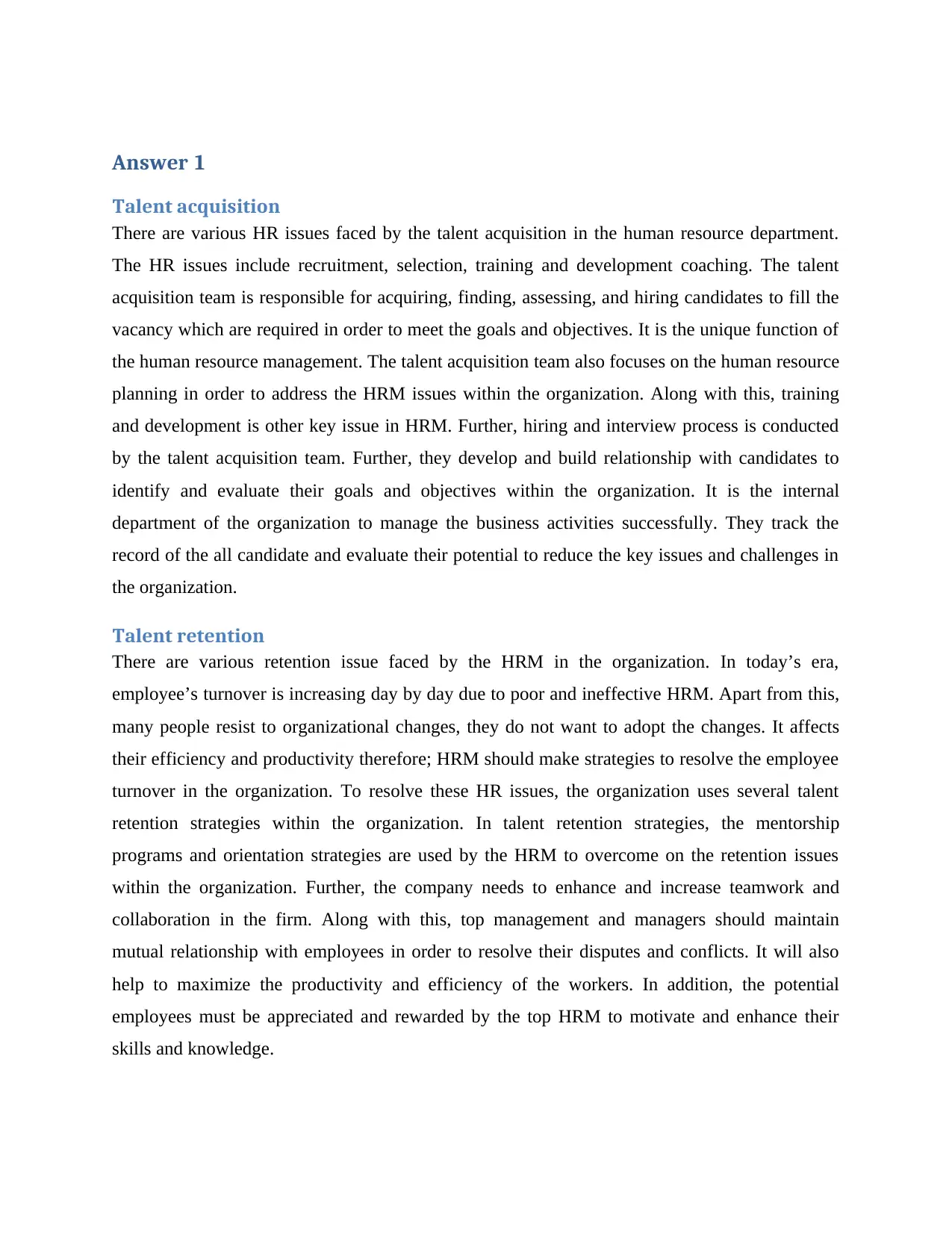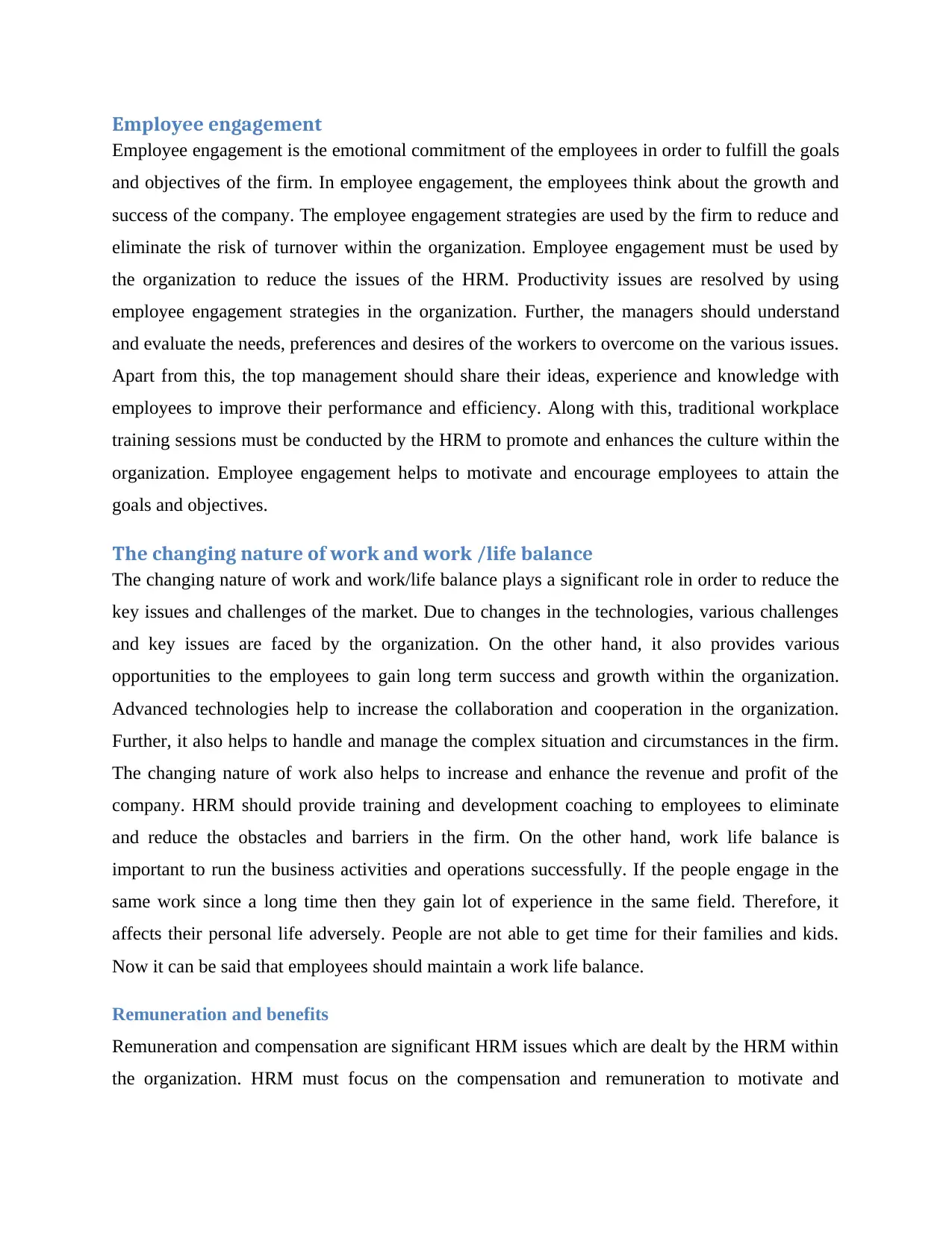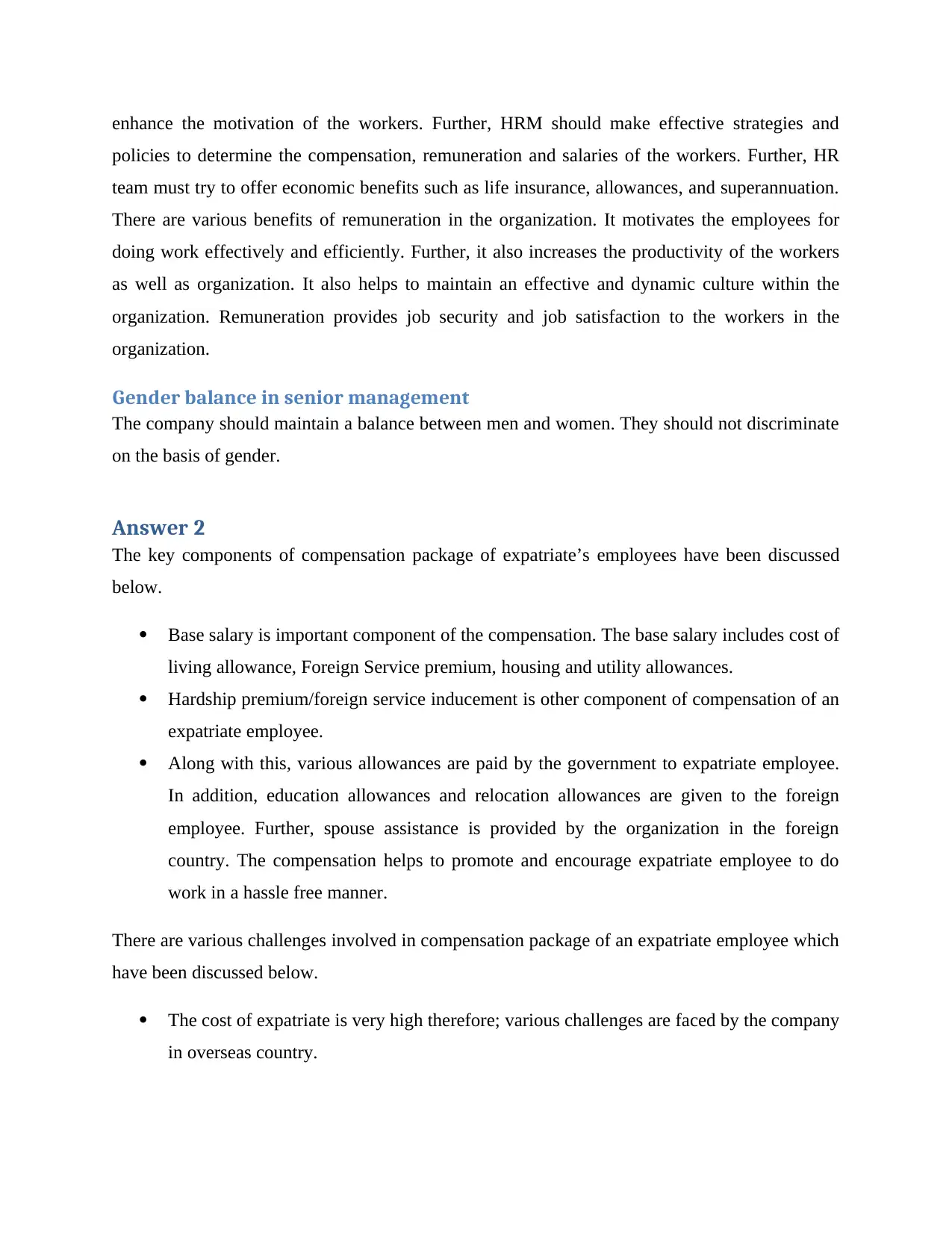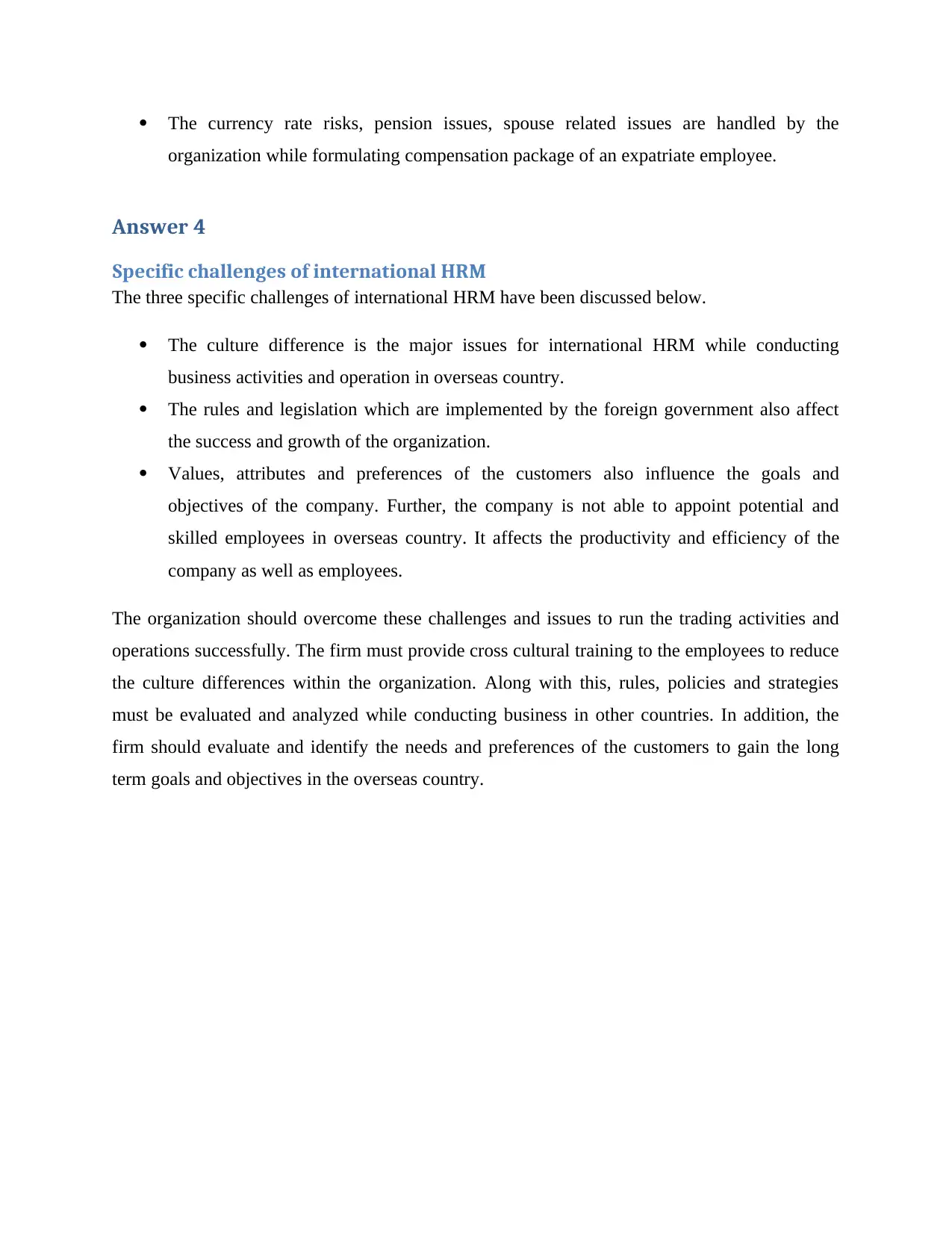Addressing Key HRM Challenges: Talent, Engagement & Compensation
VerifiedAdded on 2023/06/16
|4
|1340
|165
Report
AI Summary
This report provides a comprehensive analysis of key Human Resource Management (HRM) issues and challenges within organizations, focusing on talent acquisition, talent retention, employee engagement, work/life balance, remuneration and benefits, and gender balance in senior management. It explores strategies to address these issues, such as mentorship programs, enhanced teamwork, and effective compensation policies. The report also discusses the challenges of international HRM, including cultural differences and varying legal frameworks, and suggests solutions like cross-cultural training. Furthermore, it examines the components of expatriate compensation packages and the importance of adapting HRM practices to meet the evolving needs of both the organization and its employees. Desklib offers a platform for students to access this report and similar solved assignments and past papers for further study.

Answer 1
Talent acquisition
There are various HR issues faced by the talent acquisition in the human resource department.
The HR issues include recruitment, selection, training and development coaching. The talent
acquisition team is responsible for acquiring, finding, assessing, and hiring candidates to fill the
vacancy which are required in order to meet the goals and objectives. It is the unique function of
the human resource management. The talent acquisition team also focuses on the human resource
planning in order to address the HRM issues within the organization. Along with this, training
and development is other key issue in HRM. Further, hiring and interview process is conducted
by the talent acquisition team. Further, they develop and build relationship with candidates to
identify and evaluate their goals and objectives within the organization. It is the internal
department of the organization to manage the business activities successfully. They track the
record of the all candidate and evaluate their potential to reduce the key issues and challenges in
the organization.
Talent retention
There are various retention issue faced by the HRM in the organization. In today’s era,
employee’s turnover is increasing day by day due to poor and ineffective HRM. Apart from this,
many people resist to organizational changes, they do not want to adopt the changes. It affects
their efficiency and productivity therefore; HRM should make strategies to resolve the employee
turnover in the organization. To resolve these HR issues, the organization uses several talent
retention strategies within the organization. In talent retention strategies, the mentorship
programs and orientation strategies are used by the HRM to overcome on the retention issues
within the organization. Further, the company needs to enhance and increase teamwork and
collaboration in the firm. Along with this, top management and managers should maintain
mutual relationship with employees in order to resolve their disputes and conflicts. It will also
help to maximize the productivity and efficiency of the workers. In addition, the potential
employees must be appreciated and rewarded by the top HRM to motivate and enhance their
skills and knowledge.
Talent acquisition
There are various HR issues faced by the talent acquisition in the human resource department.
The HR issues include recruitment, selection, training and development coaching. The talent
acquisition team is responsible for acquiring, finding, assessing, and hiring candidates to fill the
vacancy which are required in order to meet the goals and objectives. It is the unique function of
the human resource management. The talent acquisition team also focuses on the human resource
planning in order to address the HRM issues within the organization. Along with this, training
and development is other key issue in HRM. Further, hiring and interview process is conducted
by the talent acquisition team. Further, they develop and build relationship with candidates to
identify and evaluate their goals and objectives within the organization. It is the internal
department of the organization to manage the business activities successfully. They track the
record of the all candidate and evaluate their potential to reduce the key issues and challenges in
the organization.
Talent retention
There are various retention issue faced by the HRM in the organization. In today’s era,
employee’s turnover is increasing day by day due to poor and ineffective HRM. Apart from this,
many people resist to organizational changes, they do not want to adopt the changes. It affects
their efficiency and productivity therefore; HRM should make strategies to resolve the employee
turnover in the organization. To resolve these HR issues, the organization uses several talent
retention strategies within the organization. In talent retention strategies, the mentorship
programs and orientation strategies are used by the HRM to overcome on the retention issues
within the organization. Further, the company needs to enhance and increase teamwork and
collaboration in the firm. Along with this, top management and managers should maintain
mutual relationship with employees in order to resolve their disputes and conflicts. It will also
help to maximize the productivity and efficiency of the workers. In addition, the potential
employees must be appreciated and rewarded by the top HRM to motivate and enhance their
skills and knowledge.
Paraphrase This Document
Need a fresh take? Get an instant paraphrase of this document with our AI Paraphraser

Employee engagement
Employee engagement is the emotional commitment of the employees in order to fulfill the goals
and objectives of the firm. In employee engagement, the employees think about the growth and
success of the company. The employee engagement strategies are used by the firm to reduce and
eliminate the risk of turnover within the organization. Employee engagement must be used by
the organization to reduce the issues of the HRM. Productivity issues are resolved by using
employee engagement strategies in the organization. Further, the managers should understand
and evaluate the needs, preferences and desires of the workers to overcome on the various issues.
Apart from this, the top management should share their ideas, experience and knowledge with
employees to improve their performance and efficiency. Along with this, traditional workplace
training sessions must be conducted by the HRM to promote and enhances the culture within the
organization. Employee engagement helps to motivate and encourage employees to attain the
goals and objectives.
The changing nature of work and work /life balance
The changing nature of work and work/life balance plays a significant role in order to reduce the
key issues and challenges of the market. Due to changes in the technologies, various challenges
and key issues are faced by the organization. On the other hand, it also provides various
opportunities to the employees to gain long term success and growth within the organization.
Advanced technologies help to increase the collaboration and cooperation in the organization.
Further, it also helps to handle and manage the complex situation and circumstances in the firm.
The changing nature of work also helps to increase and enhance the revenue and profit of the
company. HRM should provide training and development coaching to employees to eliminate
and reduce the obstacles and barriers in the firm. On the other hand, work life balance is
important to run the business activities and operations successfully. If the people engage in the
same work since a long time then they gain lot of experience in the same field. Therefore, it
affects their personal life adversely. People are not able to get time for their families and kids.
Now it can be said that employees should maintain a work life balance.
Remuneration and benefits
Remuneration and compensation are significant HRM issues which are dealt by the HRM within
the organization. HRM must focus on the compensation and remuneration to motivate and
Employee engagement is the emotional commitment of the employees in order to fulfill the goals
and objectives of the firm. In employee engagement, the employees think about the growth and
success of the company. The employee engagement strategies are used by the firm to reduce and
eliminate the risk of turnover within the organization. Employee engagement must be used by
the organization to reduce the issues of the HRM. Productivity issues are resolved by using
employee engagement strategies in the organization. Further, the managers should understand
and evaluate the needs, preferences and desires of the workers to overcome on the various issues.
Apart from this, the top management should share their ideas, experience and knowledge with
employees to improve their performance and efficiency. Along with this, traditional workplace
training sessions must be conducted by the HRM to promote and enhances the culture within the
organization. Employee engagement helps to motivate and encourage employees to attain the
goals and objectives.
The changing nature of work and work /life balance
The changing nature of work and work/life balance plays a significant role in order to reduce the
key issues and challenges of the market. Due to changes in the technologies, various challenges
and key issues are faced by the organization. On the other hand, it also provides various
opportunities to the employees to gain long term success and growth within the organization.
Advanced technologies help to increase the collaboration and cooperation in the organization.
Further, it also helps to handle and manage the complex situation and circumstances in the firm.
The changing nature of work also helps to increase and enhance the revenue and profit of the
company. HRM should provide training and development coaching to employees to eliminate
and reduce the obstacles and barriers in the firm. On the other hand, work life balance is
important to run the business activities and operations successfully. If the people engage in the
same work since a long time then they gain lot of experience in the same field. Therefore, it
affects their personal life adversely. People are not able to get time for their families and kids.
Now it can be said that employees should maintain a work life balance.
Remuneration and benefits
Remuneration and compensation are significant HRM issues which are dealt by the HRM within
the organization. HRM must focus on the compensation and remuneration to motivate and

enhance the motivation of the workers. Further, HRM should make effective strategies and
policies to determine the compensation, remuneration and salaries of the workers. Further, HR
team must try to offer economic benefits such as life insurance, allowances, and superannuation.
There are various benefits of remuneration in the organization. It motivates the employees for
doing work effectively and efficiently. Further, it also increases the productivity of the workers
as well as organization. It also helps to maintain an effective and dynamic culture within the
organization. Remuneration provides job security and job satisfaction to the workers in the
organization.
Gender balance in senior management
The company should maintain a balance between men and women. They should not discriminate
on the basis of gender.
Answer 2
The key components of compensation package of expatriate’s employees have been discussed
below.
Base salary is important component of the compensation. The base salary includes cost of
living allowance, Foreign Service premium, housing and utility allowances.
Hardship premium/foreign service inducement is other component of compensation of an
expatriate employee.
Along with this, various allowances are paid by the government to expatriate employee.
In addition, education allowances and relocation allowances are given to the foreign
employee. Further, spouse assistance is provided by the organization in the foreign
country. The compensation helps to promote and encourage expatriate employee to do
work in a hassle free manner.
There are various challenges involved in compensation package of an expatriate employee which
have been discussed below.
The cost of expatriate is very high therefore; various challenges are faced by the company
in overseas country.
policies to determine the compensation, remuneration and salaries of the workers. Further, HR
team must try to offer economic benefits such as life insurance, allowances, and superannuation.
There are various benefits of remuneration in the organization. It motivates the employees for
doing work effectively and efficiently. Further, it also increases the productivity of the workers
as well as organization. It also helps to maintain an effective and dynamic culture within the
organization. Remuneration provides job security and job satisfaction to the workers in the
organization.
Gender balance in senior management
The company should maintain a balance between men and women. They should not discriminate
on the basis of gender.
Answer 2
The key components of compensation package of expatriate’s employees have been discussed
below.
Base salary is important component of the compensation. The base salary includes cost of
living allowance, Foreign Service premium, housing and utility allowances.
Hardship premium/foreign service inducement is other component of compensation of an
expatriate employee.
Along with this, various allowances are paid by the government to expatriate employee.
In addition, education allowances and relocation allowances are given to the foreign
employee. Further, spouse assistance is provided by the organization in the foreign
country. The compensation helps to promote and encourage expatriate employee to do
work in a hassle free manner.
There are various challenges involved in compensation package of an expatriate employee which
have been discussed below.
The cost of expatriate is very high therefore; various challenges are faced by the company
in overseas country.
⊘ This is a preview!⊘
Do you want full access?
Subscribe today to unlock all pages.

Trusted by 1+ million students worldwide

The currency rate risks, pension issues, spouse related issues are handled by the
organization while formulating compensation package of an expatriate employee.
Answer 4
Specific challenges of international HRM
The three specific challenges of international HRM have been discussed below.
The culture difference is the major issues for international HRM while conducting
business activities and operation in overseas country.
The rules and legislation which are implemented by the foreign government also affect
the success and growth of the organization.
Values, attributes and preferences of the customers also influence the goals and
objectives of the company. Further, the company is not able to appoint potential and
skilled employees in overseas country. It affects the productivity and efficiency of the
company as well as employees.
The organization should overcome these challenges and issues to run the trading activities and
operations successfully. The firm must provide cross cultural training to the employees to reduce
the culture differences within the organization. Along with this, rules, policies and strategies
must be evaluated and analyzed while conducting business in other countries. In addition, the
firm should evaluate and identify the needs and preferences of the customers to gain the long
term goals and objectives in the overseas country.
organization while formulating compensation package of an expatriate employee.
Answer 4
Specific challenges of international HRM
The three specific challenges of international HRM have been discussed below.
The culture difference is the major issues for international HRM while conducting
business activities and operation in overseas country.
The rules and legislation which are implemented by the foreign government also affect
the success and growth of the organization.
Values, attributes and preferences of the customers also influence the goals and
objectives of the company. Further, the company is not able to appoint potential and
skilled employees in overseas country. It affects the productivity and efficiency of the
company as well as employees.
The organization should overcome these challenges and issues to run the trading activities and
operations successfully. The firm must provide cross cultural training to the employees to reduce
the culture differences within the organization. Along with this, rules, policies and strategies
must be evaluated and analyzed while conducting business in other countries. In addition, the
firm should evaluate and identify the needs and preferences of the customers to gain the long
term goals and objectives in the overseas country.
1 out of 4
Related Documents
Your All-in-One AI-Powered Toolkit for Academic Success.
+13062052269
info@desklib.com
Available 24*7 on WhatsApp / Email
![[object Object]](/_next/static/media/star-bottom.7253800d.svg)
Unlock your academic potential
Copyright © 2020–2025 A2Z Services. All Rights Reserved. Developed and managed by ZUCOL.




